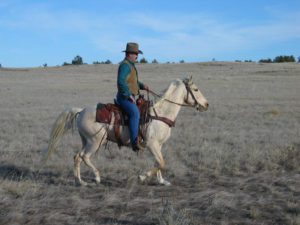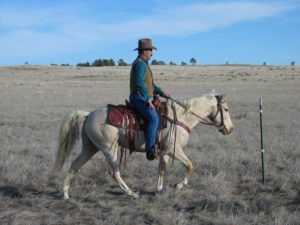In part 1, we discussed how our personal energy affects relationship, behavior, and performance issues in the horse. This occurs whether we are aware of it or not. By learning to become a craftsman of this communication tool we already use, we can be much better horsemen. This type of communication also influences horses to work at a higher level of humanship.
How do we grasp the handle of this tool and make it usable? We must first become aware of the utility and power of our energy use, and then accept its use as a real influence. Only then will we be able to understand how and what we can accomplish with this potent tool. It is essential to become more acutely attentive to what we are already subtly doing to influence the horse before we can tap this resource for conscious meaningful application. The influence we are already giving to the horse may not always be consistent or positive.
The work I referenced in Part 1 concerned ground work; engaging and disengaging both the front end and hind quarters of the horse at the same time using your body’s energy. In effect, we demonstrated how to get the horse to move by responding to your unseen training aid… your energy. Let’s continue beyond ground work and apply energy use to higher performance.
When attempting better communication with the horse, some folks exaggerate their body’s movement to “bring up the life” in their body. Their purpose is to transmit energy communication through their physical cues. They may understand the impact their energy has on the horse, but are not using it as effectively as they could. They haven’t learned how to truly focus and move their energy that allows their body cues to subsequently follow. Our common purpose may be to achieve a similar result in the horse, but their approach is much different in application. Their result often creates a horse that understands and responds to the language of over exaggeration while dulling subtle communication. The solution is to concentrate primarily on energy control and movement. Focusing on moving your energy first, will affect the horse in remarkable ways. The act of controlling and manipulating energy causes subtle physical changes to occur in your body. Those changes are transmitted in the form of physical cues the horse will “listen to”. The horse learns quickly to “read you” with much more focused attention. They are use to reading other horses in their herd similarly, so the transition to humans is natural for them.
Let’s put this whole communication process in human terms. Have you ever noticed when someone whispers or talks in low hushed tones; you lean toward them focusing on every nuance of their communication? You tend to “listen intently” to their emotion, and how they speak. The important thing to realize is our attention is grabbed not so much by what is said, but how the message is delivered. If the communication directs our attention with emotion, it causes a focusing on the message. The message may be neutral in its effect on us, but how it affects us is the most important aspect of the communication. If you don’t believe that, think about an event that occurred in your life that was very emotional. I’ll bet you can summon up details of the event, vividly recalling most of the five senses you experienced at the time. Emotionally learned lessons are driven into our long term memory because a huge amount of personal energy is invested into the event.
The most effective ways to achieve this understated use of communication is through thought. Again, thoughts are things…things you create. Create the desired outcome from the horse by visualizing what you want from start, to beyond the finish. Establish a conduit of influence through your body by controlled breathing, relaxing, feeling and most importantly knowing how you and the horse should work together when executing any maneuver of any discipline. By doing this, you now control the performance of the horses’ body, mind and emotion.
Let me give one example of how this applies to training for proper and consistent gait. It is the most effectual way I know to teach a gaited horse to collect or get into frame naturally without any mechanical aids what so ever. The proper emotional support you provide during this training creates the long term memory you want in your finished horse.
I first evaluate in what gait the horse is moving. If the horse is pacey or lateral in its gait, I know that to correct it, the horse must progress out of a ventroflexed posture. If for instance simply raising the back is the only issue to correct the gait, I visualize what the horse needs to do to accomplish this. Lowering the neck and tipping the nose in, or in other words tightening the back line is the solution. The horses’ abdominal muscles can also contract to tighten and lift the back. This will cause the hind legs to move under the horse to realize a more contained frame or better collection. After this visualization, now I control my body by thinking about what it needs to do to support the horse. One of the most important aids is to properly breathe. It seems obvious that we must, but when concentrating on something, we tend to breathe shallowly or not at all. This causes the body to stiffen and not relax or in the least, not be fluid in movement. It is one of the most common mistakes I see people make. Breathe deeply, and in a very controlled manner. It is impossible to stay tense when breathing deeply with control. I relax mentally and physically, and then focus my energy up through my body. I consciously “pull” the horses’ energy with me just as I did with the engaging / disengaging exercise on the ground. I am now not just influencing the overall movement of the horse, but also movement of body mechanics of the horse to attain the overall proper movement.
 |
 |
This gelding named Bum, is traveling in a stepping pace; an uneven lateral 4 beat gait. His back is dropped (ventroflexed), neck and head are high with the nose pushed out. Legs do not stretch forward up under him with extended reach. I am not pulling him into the ventroflexed position with the reins, they are loose and light. I lift the energy up in my body; yet maintain a calm, low vibrational energy so as not to induce excitement in Bum in the two pictures of the series above. I am visualizing and concentrating on pulling up on his energy with my energy to round his back toward a more neutral position. He begins to respond quickly and the transition is seen below.
 |
 |
Notice how Bum’s back rounds upward from the ventroflexed position as his neck and head come down. His head moves more toward the vertical as well. Take note of the extended reach his hind legs can now achieve under him. You can see his body relax as he transitions into this gait with more forward progress. Bum’s neck continues to lower and lengthen as his back raises even more. He is more relaxed and natural in his posture and movement with extended reach. He is now in the 3 foot support phase of the running walk; an even 4 beat gait. The transition happens quickly enough that he pulls the slack out of the reins before I can react to give him more rein.
All of these techniques working together, along with allowing the horse to be able to move its body through your good equitation, allows for the desired gait to be easier to attain. Visualize your body coming up off the horses back so it can raise the spine easier. Visualize and focus your energy not just upward, but also forward of the saddle just as you would your body in a more forward seat to help the horse move. As I reach the goal of a consistent gait, I continually adjust my energy and the horses’ energy to maintain gait with the least amount of work from the horse. While attaining gait in this manner, the horse should and will relax because its emotional state is reflecting your emotional state. This is what creates a happy, willing horse that is eager to work for you.
A very important component to all of this is to make sure you are not hindering or preventing the horse from being able to move as desire. Allow the horse to move freely just as it would if you weren’t on its back. Make yourself an assistant, not a burden for the horse. Continue to support the horse by knowing what it needs to consistently do to sustain the gait. Know that it will move or behave as you wish and it can.
Focusing on what might go wrong is also a thinking process that creates the behavior or movement you do NOT want. Don’t do it. When you catch yourself doing it, change it. Knowing and seeing the desired end result before it happens aligns your energy and the horses’ energy with your wanted outcome. You are consciously influencing and manipulating the horses’ energy with your own energy. This merger and balance of energies is what defines true higher horsemanship.
By leading your horse in this manner, you develop the trust and kinship we desire in a well trained mount. Always be consistent in your approach to supporting your horse. You have a huge responsibility to yourself and to the horse when you take the role of leader of your herd of two. Always give the horse a reason to trust, not second guess you. With each interaction you have with the horse, the marriage of your energies to accomplish a goal will get easier to do and new performance of any kind can be attained easier.
To recap the important points:
- Thoughts are things.
- As the horse is performing, know it will do exactly as you visualize.
- DO NOT think about what you don’t want to happen or fear will happen.
- Appropriate energy placement in the body is crucial.
- Control and consistency of energy movement keeps the horse steady in its performance.
- When moving or adjusting your energy to move the horse, pull or push on the horses’ energy with your energy.


